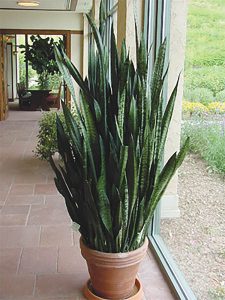February 1, 2025
Caring for Sansevieria
By Aaron J. Steil
Iowa State University Externsion Horticulture Specialist
 Sansevieria, also known as snake plant, St. George’s sword or mother-in-law’s tongue, is a resilient houseplant that is grown for its striking appearance and low maintenance needs. Its tall, sword-like leaves and unique variegation make a beautiful addition to most indoor spaces. This hardy plant is known for its ability to thrive in a variety of conditions, making it an ideal choice for both novice and experienced gardeners.
Sansevieria, also known as snake plant, St. George’s sword or mother-in-law’s tongue, is a resilient houseplant that is grown for its striking appearance and low maintenance needs. Its tall, sword-like leaves and unique variegation make a beautiful addition to most indoor spaces. This hardy plant is known for its ability to thrive in a variety of conditions, making it an ideal choice for both novice and experienced gardeners.
What types of sansevieria are commonly grown indoors?
The most common species in homes is the snake plant (Dracaena trifasciata), a species native to tropical West Africa. The long sword-like leaves grow from the ground in rosettes and come in a variety of colors and patterns. Bird’s nest types, such as ‘Hahnii,’ have rosettes of much shorter leaves, typically less than 8 inches long, forming a funnel shape.
How do I care for sansevieria?
Sansevieria prefers bright, indirect light. This is light bright enough to cast a shadow but not directly in the sun’s rays. Plants tolerate low light levels very well, although this can lead to muted leaf coloration and patterns.
Plant in a well-drained potting soil, such as cactus mix or potting soil amended with perlite. Water plants only after the soil has completely dried out. Plants can go weeks, sometimes months, without water, but if plants stay wet, root rot develops, causing leaves to turn yellow and collapse, eventually leading to plant death. Wet conditions can be caused by frequent watering, using containers that don’t have drainage holes or allowing water to sit in saucers or outer pots.
Grow plants in average home temperatures, although they prefer it a little warmer (70-90 degrees Fahrenheit is ideal). Avoid cold drafts. Frequent fertilizing is not necessary, but using an all-purpose fertilizer at half or quarter strength in the spring promotes healthy growth.
Is sansevieria toxic to pets or people?
Sansevierias are mildly toxic to humans and pets. Plants contain saponins, which cause nausea, vomiting, diarrhea and gastrointestinal discomfort. All species of sansevierias should never be ingested and should be kept out of reach of children, dogs and cats.
Do sansevierias flower?
It is rare for sansevieria to flower when grown as a houseplant. When provided with abundant light and good fertility, sansevieria may produce flowers. Flowers form along a long stalk that arises from the base of the rosette. The cream-to-greenish-white tubular flowers have strap-like petals that curl back to reveal prominent stamens.
Aaron J. Steil is Iowa State University Consumer Horticulture Extension Specialist, He can be reached at 515-294-8953 or ajsteil@iastate.edu.
Filed Under: Community, Family, Featured, Health & Wellness, News
Trackback URL: https://www.50pluslife.com/2025/02/01/caring-for-sansevieria/trackback/


